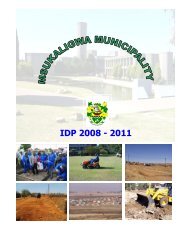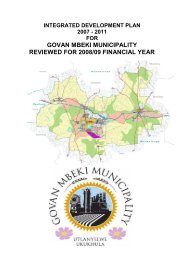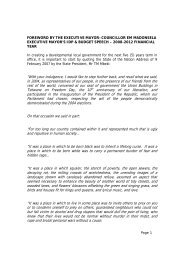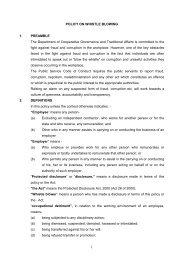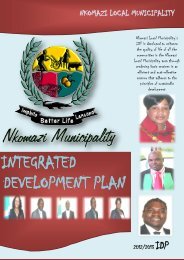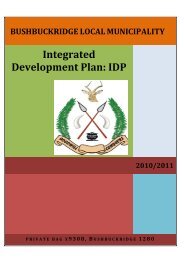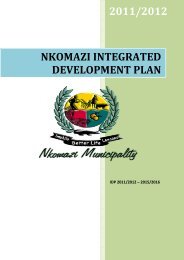Lekwa Local Municipality 2013/14 - Co-operative Governance and ...
Lekwa Local Municipality 2013/14 - Co-operative Governance and ...
Lekwa Local Municipality 2013/14 - Co-operative Governance and ...
Create successful ePaper yourself
Turn your PDF publications into a flip-book with our unique Google optimized e-Paper software.
“To be the leading, people centered municipality excelling in economic growth, development <strong>and</strong> governance”development priorities <strong>and</strong> enabling intergovernmental alignment.” In essence then, the Provincial Growth<strong>and</strong> Development Strategies are aimed at providing strategic directives to District <strong>and</strong> <strong>Local</strong> Municipalities informulating their more detailed Integrated Development Plans (IDPs), <strong>and</strong> Spatial Development Frameworks(SDF). It is thus essential that the issues <strong>and</strong> directives emanating from PGDSs’ be compatible with the vision,priority areas, <strong>and</strong> guidelines of SDFs of local <strong>and</strong> District municipalities.Flowing out of a thorough SWOT analysis <strong>and</strong> identified trends, the Province has identified six priority areas ofintervention as part of the PGDS, namely:Economic Development (i.e. investment, job creation, business <strong>and</strong> tourism development <strong>and</strong> SMMEdevelopment);Infrastructure Development (i.e. urban/rural infrastructure, housing <strong>and</strong> l<strong>and</strong> reform);Human Resource Development (i.e. adequate education opportunities for all);Social Infrastructure (i.e. access to full social infrastructure);Environmental Development (i.e. protection of the environment <strong>and</strong> sustainable development); <strong>and</strong>Good <strong>Governance</strong> (i.e. effective <strong>and</strong> efficient public sector management <strong>and</strong> service delivery).In line with strengthening the intergovernmental planning system <strong>and</strong> to ensure that there is sustainablegrowth <strong>and</strong> development in the province, the PGDS has adopted the following as guiding posts:Internationally, the United Nation’s Millennium Development Goals (MDGs); <strong>and</strong>Nationally, the Accelerated <strong>and</strong> Shared Growth Initiative for South Africa (ASGISA) <strong>and</strong> the National SpatialDevelopment Perspective (NSDP) of South AfricaKey Implications for <strong>Lekwa</strong> <strong>Local</strong> <strong>Municipality</strong>The Mpumalanga Provincial Growth <strong>and</strong> Development Strategy aims to address the key developmental <strong>and</strong>economic challenges in the province.Municipal’s Intervention: In order to align the IDP to the PGDS, the <strong>Municipality</strong> has identified a number ofinterventions to support the implementation of the PGDS, evident in the Municipal’s <strong>Local</strong> EconomicDevelopment <strong>and</strong> Spatial Development Framework sector plans.2.7 Accelerated Shared Growth Initiative of South Africa (AsgiSA)The m<strong>and</strong>ate by the South African government in 2004 to half poverty <strong>and</strong> unemployment by 20<strong>14</strong>resurrected commitment in the public sector delivery trajectory.Dismal malfunction of the previous highly contentious GEAR to address economicBacklogs resulted in the formation of a new economic strategy today known as AsgiSA.The South African government's AsgiSA aims to guide <strong>and</strong> improve on the country's remarkable economicrecovery, raising economic growth to 6% <strong>and</strong> halving poverty <strong>and</strong> unemployment by 20<strong>14</strong>. AsgiSA is a microeconomicstrategy that strives to accelerate growth. It is a national shared growth initiative that was informedby extensive consultation from all sectors. The two main objectives of AsgiSA include:To align its efforts by halving poverty by 50% in 20<strong>14</strong>; <strong>and</strong>To realize annual growth rates that averages 4.5% or higher between 2005 <strong>and</strong> 2009 <strong>and</strong> averagegrowth rate of at least 6% of gross domestic product (GDP) between 2010 <strong>and</strong> 20<strong>14</strong>.AsgiSA is also informed by the following binding constraints that have been identified as majorstumbling blocks to growth <strong>and</strong> require commitments based on uprooting them:<strong>Co</strong>ntinuous instability <strong>and</strong> level of currency;The cost, efficiency <strong>and</strong> capacity of the national logistics system;Lack of suitably skilled labor amplified by the impact of apartheid spatial patterns on the cost oflabor;Obstacles to entry, limits to competition <strong>and</strong> limited new investment opportunities;Regulatory environment <strong>and</strong> the burden on small <strong>and</strong> medium businesses; <strong>and</strong>29 | P a g e - D r a f t i n t e g r a t e d D e v e l o p m e n t P l a n 2 0 1 3 / 2 0 1 4




